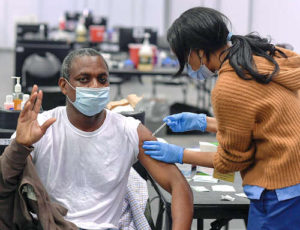
Those who have known me long enough have, at some point or another, heard one of my diatribes about poorly chosen vaccine photos in the media. These photos often feature screaming babies, wincing mothers, giant needles (usually medically inaccurate) and similarly negative images that can undermine public health. While it’s not a journalist’s job to promote public health per se, we certainly need to avoid undermining it.
With the COVID-19 vaccine — perhaps because most of the pictures are still of adults and there are so many of them — I’m not seeing nearly as many negative images. Still, I do periodically have to cringe. So, here are some tips to consider if you have the opportunity to choose the photo (or contribute in the selection process) to illustrate a story on vaccines, both during the pandemic and afterward.
Many (most?) vaccine stories may not actually need a photo with a needle in it. A bandage on an arm, a person with a healthcare worker, a vial or similar images are often adequate. That said, during the current COVID-19 vaccination campaign, there are advantages to images that show people being stuck with the vaccine. For one thing, it normalizes the practice of receiving the shot and shows people who might feel nervous exactly what it looks like.
In addition, many of those getting shots in this instance are happy, relieved, even excited, not the emotions we traditionally associated with vaccines in past news imagery. But I’m grateful to see the change and think it’s a step in the right direction since vaccination is a healthy behavior instead of a negative one.
If an image includes a needle, it should not be the photo’s focal point or take up the entire image. It should be proportional to the people in the photo rather than a close-up of just the needle or a needle and an arm.
This has been less of a concern with COVID-19 vaccination but has been a problem in the past: Any needle or full syringe in an image should show an actual vaccine needle, not just a random colorful syringe or a syringe of something else. I’ve found that the vast majority of stock photos with a key word of “vaccine” actually do not show the currect type of needle, which makes them unethical to use.
Avoid using photos that show a person screaming or wincing horribly. Again, that’s been less of an issue with COVID-19, but I still see it in photos relating to children’s immunizations. I’ve heard people try to argue that using those images is fine because it’s “realistic” or “represents reality” and that I’m unethically editorializing by saying not to use them.
On the contrary, those images have traditionally only been used because they look dramatic, which is what many photo editors look for in an image. In reality, they do not represent the norm. The majority of people — including children — who receive vaccines don’t cry or scream or make horrible faces (which any family doctor or pediatrician will tell you). Yes, some do cry, scream, wince, etc., but that’s not representative experience and contributes to a negative stereotype. Again, a vaccine is a health intervention that improves or supports health and typically involves a positive connotation, aside from stories examining serious safety concerns such as blood clots, etc. It’s contrary to photojournalism ethics and undermines public health to use images of people crying, screaming, wincing, etc., constantly.
Where can you find quality images? If you or your publication don’t have access to a photo library such as AP, Getty, Reuters, etc., I recommend checking out a library of free images sponsored by the American Academy of Pediatrics and Self Magazine, shot specifically to provide vaccination photos to journalists. The downside to these photos, at the moment, is that they don’t show people who are wearing masks, which is preferred for COVID-19 vaccination use. But on the plus side, the photos are medically accurate, do not communicate a negative image, and include a wide array of different patients, from children to adults of all different sizes, shapes and colors.






